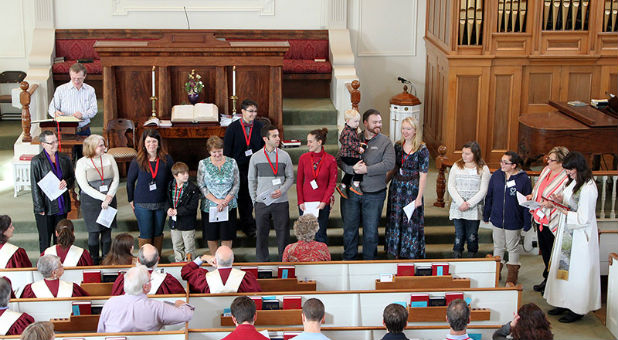Hope, by nature, is defiant, counterintuitive and lodged in surprising places.
So a new report detailing the spiritual, demographic and financial challenges faced by small religious congregations meant little to the Rev. Robin Bartlett.
She plants her hopes for First Church in Sterling, Mass., on firmer ground.
“This does not look like a dying and sad church. It looks like a vibrant and active church on a Sunday morning,” said Bartlett, who usually sees 130 people on Sundays, even though the sanctuary was built for the days when more than 300 came to worship.
Just this year, 30 new members have joined, including young adults such as Ann Taft, 28, who delighted in the warm welcome at First Church: “Everyone was just so excited that I was there.”
More people in the pews, more energy for programs, more funds to maintain the roof — these are all keys to survival for such small congregations, according to the latest Faith Communities Today report, released Monday (Jan. 4) by the Hartford Institute for Religion Research.
It finds that congregations with fewer than 100 in weekend attendance — the most vulnerable to collapse — rose to 58 percent in 2015, up from 49 percent five years ago.
Yet the report is optimistically titled: “American Congregations 2015: Thriving and Surviving.”
David Roozen, author of the report and retired director of the institute, wanted to highlight signs of hope in the research by asking about innovation, growth and positive change, particularly in those very small churches.
He analyzed data from clergy and senior church leaders at 4,436 U.S. congregations. Although congregations serving Jews, Muslims, Buddhists and other religions were represented, they were too few for analysis. Ninety percent of U.S. congregations are Protestant (22 percent mainline and 68 percent white evangelical or historically black congregations) and 6.5 percent are Catholic, said Roozen.
Survival is relatively easy to measure.
When the Rev. Jonathan Iguina arrived atIglesia Cantico Nuevo (New Song Church) three years ago, the Pentecostal congregation in a commercial plaza in Longwood, Fla., was on the verge of shutting its doors. The last 19 people in the congregation welcomed the new pastor the first Sunday — and never came back.
Iguina dug in. He cold-called former members. He found musicians to play the instruments left behind. He cut “unfruitful” programs such as “a visiting ministry that wasn’t visiting anyone” and boosted outreach to families with children.
As he concentrated on “nurturing the people I found, setting a focus on drawing closer to God,” Iguina said, attendance has inched up to 90 on Sunday mornings, and the church’s debt has been replaced by a surplus.
Cantico Nuevo is an exception, according to the study’s grim overall findings for congregations under 100 in weekend worship: Only about 18 percent say they’re thriving, and 29 percent declare themselves OK.
Meanwhile, two mainline churches in Northern Virginia are selling their grounds to nonprofit groups that will build affordable housing. And at the Southern Baptist Convention, a report showed an average of 1,000 churches a year disappeared from the denomination’s database.
Roozen found that congregations willing to “change to meet new challenges” fell to 62 percent in 2015, down from 74 percent a decade ago.
“Thriving,” however, is a more subjective term.
“It comes down to being all you can be in a religious setting,” he said. “These congregations feel they are energetically living out their understanding of their call.”
Hope thrives where change is welcome, Roozen said. “Thriving congregations are nearly 10 times more likely to have changed themselves than are struggling congregations.”
“That’s critical,” said Nancy Ammerman, professor of sociology of religion at Boston University. She observes that those aging congregations slipping toward insolvency “can take a long time to die because a handful of really determined folks will keep it going. That works — if they are willing to revolutionize themselves.
“People haven’t lost the urge to congregate together spiritually. But how they do it is being expressed differently and the churches that do well are reshaping constantly,” she said.
The Rev. Jon Brown left a denominational headquarters job to lead a congregation of 45 participants at Old Bergen Church in Jersey City, N.J. Five years later, Old Bergen, a multiethinic, multiracial congregation, averages 100 people in the pews on Sundays — and tries new things constantly.
To him, this congregation is “a treasure hidden in a field,” he said, echoing a parable in the Gospel of Matthew.
See an error in this article?
To contact us or to submit an article






















